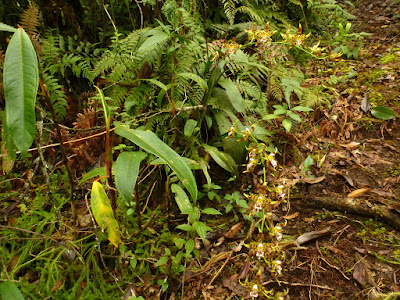Odontoglossum hallii is found in Colombia, Ecuador and Peru. It grows on small trees or in leaf litter of very wet montane cloud forests at altitudes of 1200 to 3000 meters above sea level.
Odontoglossum hallii also called as Hall's Odontoglossum, Odontoglossum chaetostroma, Odontoglossum victor, Odontoglossum hallii var. leucoglossum, Odontoglossum hallii var. xanthoglossum, Oncidium hallii, is a species of the genus Odontoglossum. This species was described by John Lindley in 1837.
IDENTIFY ODONTOGLOSSUM HALLII ORCHID PLANT
Odontoglossum hallii is found in Colombia, Ecuador and Peru. It grows on small trees or in leaf litter of very wet montane cloud forests at altitudes of 1200 to 3000 meters above sea level.
It is a medium sized, epiphytic or terrestrial cold to cool growing orchid with clustered, oblong-ovoid to ovoid, compressed, ancipitous, 7-12 cm long pseudobulbs enveloped basally by 2 to 4, distichous, leaf bearing sheaths and carrying 1 or 2 apical, oblong-lanceolate to ligulate, acute, up to 30 cm long leaves that are conduplicate below into a petiole-like stem.
Hall's Odontoglossum blooms in the spring and summer on an basal, arising from the leaf axils, erect to arcuate, to 60 cm long, racemose or rarely paniculate, 4 to 20 flowered inflorescence arising on a mature pseudobulb with large, variably colored flowers. Sepals and petals nearly equal, ovate-lanceolate, exceedingly unguiculate, yellow with large, often very dark, blotches of purplish-brown. Lip white, with a few rich spots, oblong-acuminate, jagged at the edges, with a large and handsome yellow Crest, consisting of a multitude of flattened but sharp-pointed teeth, pointing sideways and downwards. Column white, winged, the wings broken into teeth or cirrhi, of which the uppermost is much the largest.
ODONTOGLOSSUM HALLII ORCHID PLANT CARE AND CULTURE
Cultural information should only be used as a guide, and should be to be adapted to suit you. Your physical location; where you grow your plants, how much time you have to devote to their care, and many other factors, will need to be taken into account. Only then can you decide on the cultural methods that best suit you and your plants.
Light:
Odontoglossum hallii need a light level of 10000-15000 lux for mature plants, but less for young plants and when temperatures are high (70% shade cloth over summer and more light in winter). Leaves turn reddish blue if receiving too much light and leaf loss will occur if too sun damaged. Dark green leaves indicate insufficient light. A slight bronzing of the leaves and older bulbs indicates the light is good for flowering.
Temperature:
Hall's Odontoglossum should be grown under cool temperature conditions. In summer, the optimum temperature range is between 8°C and 26°C. In winter, it need a minimum nighttime temperature of 7 to 12°C, with daytime temperatures of 10 to 17°C. The diurnal difference between day and night is usually 8 - 10°C. In their natural environment night temperatures can fall to 5°C and although tolerant of low temperatures down to 0°C, they will not tolerate frosts.
Humidity:
This orchid prefer humidity levels between 55-75%; higher levels of 60-80% require good air movement especially in the cooler months. Plants can also tolerate humidity levels down to 40% which can be maintained or increased with morning and evening misting.
Substrate, growing media and repotting:
Odontoglossum hallii are usually grown in pot using small bark (5-10mm) perlite potting mix (5:1) or in sphagnum moss and perlite (70:30) as substrate. Some growers place a layer of sphagnum moss on the top of the pot to reduce evaporation and keep the roots cool. They can also be grown in perlite with a layer of gravel on the top.
These plants should be repotted every year to every 2 years in spring or autumn when new growths are about half mature. They should be grown in small squat pots that allow more frequent watering. The base of the new growth should be planted about 1.5cm into the bark but no deeper. Keep bark barely moist until new roots appear then resume normal watering.
Watering:
Hall's Odontoglossum like abundant water and require frequent watering in warmer months. They must never be allowed to dry out. During summer irrigation will be required every 2 -3 days, however during winter rates may drop to once every 10 – 14 days. Misting daily in very hot weather is recommended. To reduce leaf spotting, avoid watering in the heat of the day or late afternoon in warmer months. Also avoid wetting the leaves and water the pot, not the leaves.
Fertilizer:
This plant require frequent application of half to quarter strength fertilizer all year round but less in winter. Apply fertilizer every 2 weeks when growing actively but monthly when less active. They are not gross feeders and too much fertilizer will harm their roots and turn leaf tips brown. Use of high phosphorus or potassium fertilizers as plants approach flowering can increase flower count and substance.
Rest period:
Odontoglossum hallii do not a rest period to stimulate flowering nor in winter. But they need less water in the winter, especially if they grow under the conditions of a dark, short day that occurs in moderate latitudes. You can let the plants dry between the next watering, but you must not let the plants stay dry for a long time. Fertilization should be limited or should be completely abandoned until spring, when stronger watering resumes.

















COMMENTS